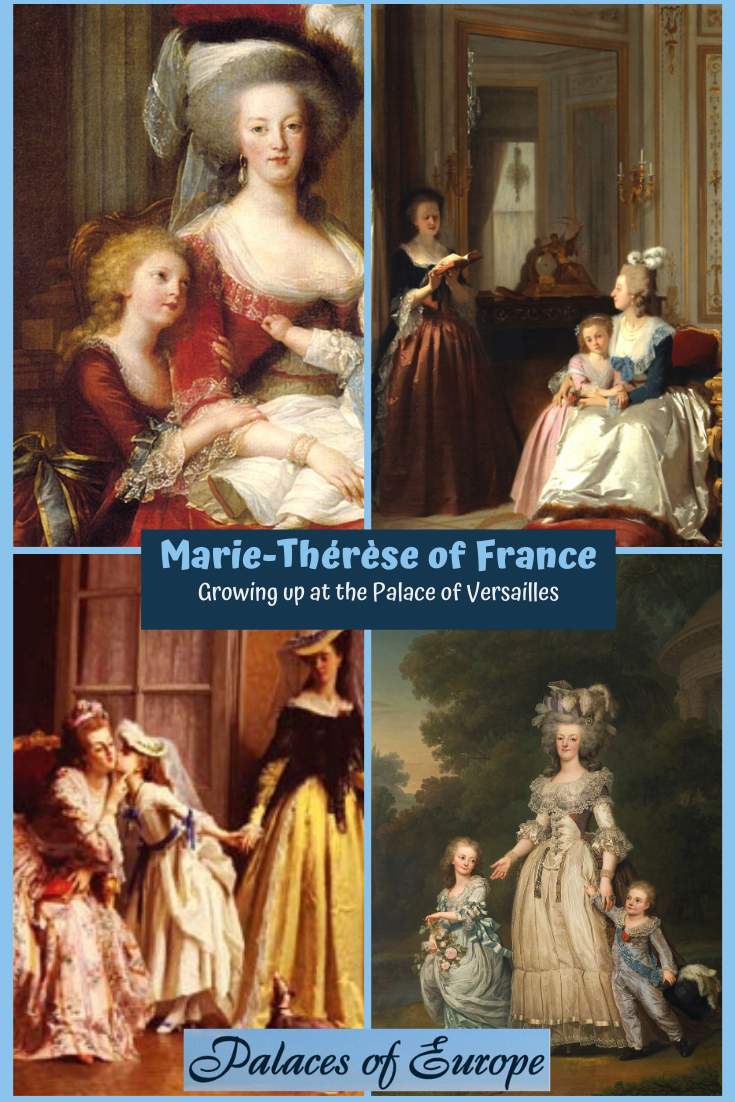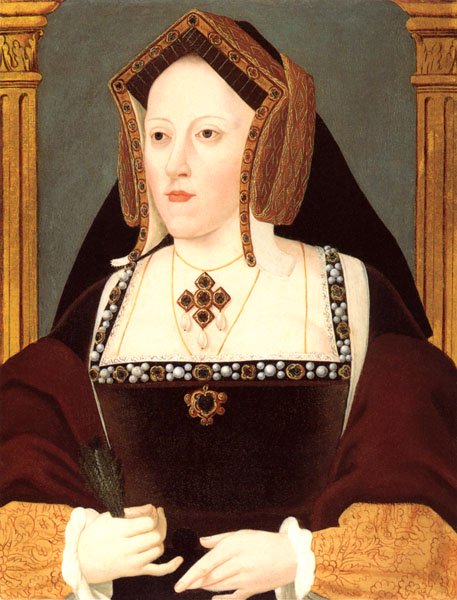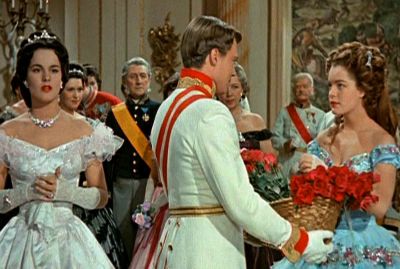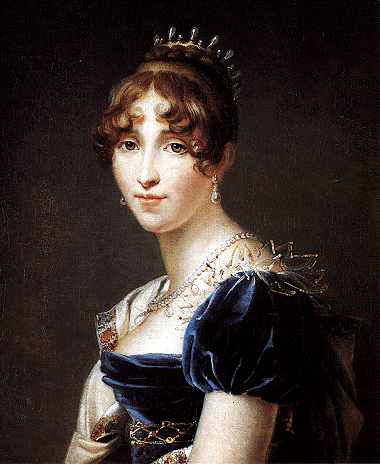Marie-Thérèse of France
Most unhappy person in the world
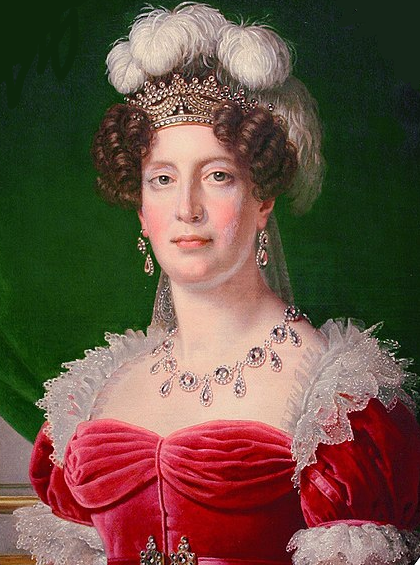 Marie-Thérèse of France, Duchess of Angoulême
Marie-Thérèse of France, Duchess of AngoulêmeMarie-Thérèse of France wrote these words on the wall of her cell in the Tower prison.
She was locked away there for three years, four months and five days during the French revolution. Her crime? She was the daughter of King Louis XVI and Queen Marie Antoinette of France.
She was the only one of the royal family who survived. Born as Madame Royale (daughter of the king), she became prisoner, refugee, Duchess, Dauphine (Wife of the heir apparent to the French throne) and even Queen of France for about twenty minutes.
Napoleon called her 'the only man in the Bourbon family' when she refused to leave Bourbon when his army marched in during the hundred days.
DISCLOSURE: I get commissions for purchases made through some of the links in this article.
Growing up at the Palace of Versailles
The first 10 years of her life Marie-Thérèse lived at the overwhelming, unreal world of the Palace of Versailles. The Palace of Versailles was home to the French kings since Louis the XIVth moved the Royal household there in 1682. Little had changed since then, the rigid etiquette still determined the daily life of everyone living there.
Since it took her parents 7 years to get pregnant, the birth of Marie-Thérèse on December 19, 1778, was very much celebrated. The court and country were anxiously waiting for an heir to the throne. The fact that she was a girl was of course very disappointing since under Salic law woman were excluded from succession to the throne. However, the birth prooved that the marriage of Louis and Marie Antoinette was finally consummated and there was nothing physically wrong with them.
The long-awaited heir Louis Joseph Xavier François, Dauphin of France, was born in in 1781, followed by Louis-Charles de France, Duke of Normandy, in 1785, and Sophie Hélène Béatrix, Madame Sophie, in 1786.
Marie Antoinette, Marie-Thérèse's mother, was very found of her children and spend a lot of time with them. She tried to escape the formal, hypocrite environment of the Versailles palace by spending as much time as possible in her little hide-away the Petit Trianon and what is now known as the Queen’s Hamlet.
Despite her reputation of being a materialist, she tried to teach her children how fortunate they were, having them play with children of a lower rank and encouraging them to give their toys to the poor.
Nothing but tragedies in the life of Marie-Thérèse
Already at a young age tragedy struck the life of Marie-Thérèse. Here little sister Sophie died in 1787, only 11 months old. Her brother Louis Joseph, the Dauphin, died in 1789 at age 7 from tuberculosis.
A month later the political situation in France exploded by the fall of the bastille on 14 July 1789. This was followed by the march of an angry mob who invaded the Palace of Versailles on 5 October 1789. The royal family escaped the invaders by fleeing to the King's apartments, anxiously listening to the invaders wrecking the rooms of the palace. The life of the 10-year-old Madame Royale and her family changed for good. They would never return to Versailles. The crowd demanded the royal family to move to the Tuileries Palace in Paris. This was, in fact, their first prison, as they were watched constantly. The king's power evaporating into thin air.
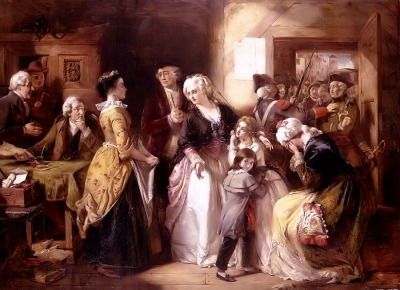 The arrest of the Royal family in Varennes
The arrest of the Royal family in VarennesOn the evening of 20 June 1791, the 12-year-old Marie-Thérèse and her family dressed up and fled the Palace. They depicted a Russian aristocrat and her entourage. Marie-Thérèse and Louis-Charles both dressed as girls, played the children of a Russian lady. This lady was, in fact, their governess. Marie-Antoinette and King Louis XVI pretended to be her servants. The party made it to Varennes, close to the border, where they were caught. They were escorted back to Paris by thousands of armed men, both guards and citizens. This was a turning point for the French Royalty, their time was up.
This flight was considered treason by the revolutionary forces. Not soon after the royal family was moved to the Temple Tower, a medieval prison. Monarchy was abolished and the Royal family and nobility of France faced trial and death by the guillotine.
Marie-Thérèse spent over 3 years in the Temple Tower, from 13 August until 18 December 1795. She was imprisoned together with her father Louis XVI, her mother Marie Antoinette, her Aunt Elisabeth and her little brother Louis Charles. She was the only one to get out of there alive.
The first one to go was her father, Louis XVI, who was executed on the guillotine on 21 January 1793. Three women and a little boy remained behind.
With the King's death, the revolutionary rulers face a new problem. What to do with the little boy, eight-year-old Louis Charles? He was of course seen as the new King of France by the royalists. On 3 July 1793, he was taken away from his mother, sister and aunt, and put in a private cell on another floor of the tower.
A month later, on 2 August, Marie-Thérèse's mother Marie Antoinette was taken to the Conciergerie. There were now only two women left until Marie-Thérèse's aunt Élisabeth was taken away on 9 May 1794. Now Marie-Thérèse was completely alone. She is 15 years old when she writes these words on her cell wall:
"Marie-Thérèse-Charlotte est la plus malheureuse personne du monde. Elle ne peut obtenir de savoir des nouvelles de sa mère, pas même d'être réunie à elle quoiqu'elle l'ait demandé mille fois. Vive ma bonne mère que j'aime bien et dont je ne peux savoir des nouvelles. Ô mon père, veillez sur moi du haut du Ciel. Ô mon Dieu, pardonnez à ceux qui ont fait souffrir mes parents."
"Marie-Thérèse Charlotte is the most unhappy person in the world. She can obtain no news of her mother; nor be reunited to her, though she has asked it a thousand times. Live, my good mother! whom I love well, but of whom I can hear no tidings. O my father! watch over me from Heaven above. O my God! forgive those who have made my parents suffer."
She has only two books, 'The Imitation of Christ' and 'Voyages' by La Harpe she reads them over and over again. She does not know what happened to her parents and aunt. She can hear her brother cry through the walls of the temple tower, but has no contact with him. From June 8, 1795, she did not hear him anymore...
A few days after the death of her brother, a lady is sought to join Marie-Thérèse in her cell as a companion. Madame Renée de Chanterennewsa is picked for this job and started her duties on 15 June 1795. She is the one that tells Marie-Thérèse about the ill fate of her family members. Marie-Thérèse is devastated.
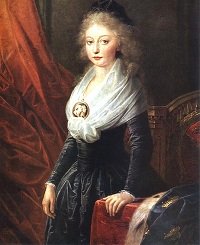 Marie-Thérèse in Vienna in 1796
Marie-Thérèse in Vienna in 1796Only after the death of Robespierre, the government began negotiating the release of Marie-Thérèse with her family members at the Austrian court.
She is liberated on 18 December 1795 in exchange for some French prisoners. She arrived in Vienna on 9 January 1796, where she initially lived at the Hofburg court of her cousin, the Holy Roman Emperor Francis II. The emperor expected her to marry his son Archduke Karl. Marie-Thérèse is not very fond of her Austrian relatives, who she thinks betrayed her mother; they did nothing to save her from the guillotine. So she leaves Viena very quickly to live with her French relatives.
Her father's eldest surviving brother, the Comte de Provence, lives in Jelgava Palace in Mitau, as a guest of Tsar Paul I of Russia. After the death of Marie-Thérèse's brother, he had proclaimed himself King of France as Louis XVIII. Together with many old courtiers that found exile at this palace, they tried to recreate the court life of Versailles. They even held the lever and coucher ceremonies as they did in Versailles.
Louis XVIII had no children of his own, so he planned the succession by asking Marie-Thérèse to marry her first cousin Louis-Antoine, Duc d'Angoulême. Louis-Antoine was the son of her fathers younger brother (and the future Charles X). Marie-Thérèse agrees and they get married on 10 June 1799.
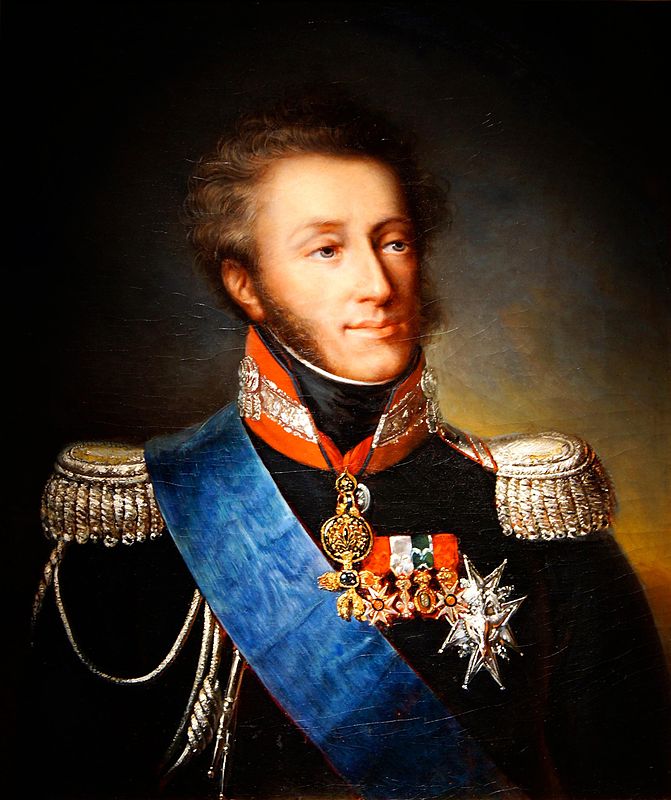 Louis-Antoine of Artois, Duke of Angoulême. Husband of Marie-Thérèse of France
Louis-Antoine of Artois, Duke of Angoulême. Husband of Marie-Thérèse of FranceNapoleon I abdicates for the first time in 1814.
The long years of exile ended with the first Bourbon Restoration.
Louis XVIII stepped upon the throne of France, twenty-one years after the death of his brother Louis XVI.
Louis XVIII died on 16 September 1824 and was succeeded by his younger brother, the comte d'Artois, as Charles X. Marie-Thérèse became Dauphine of France, the last one as history would turn out.
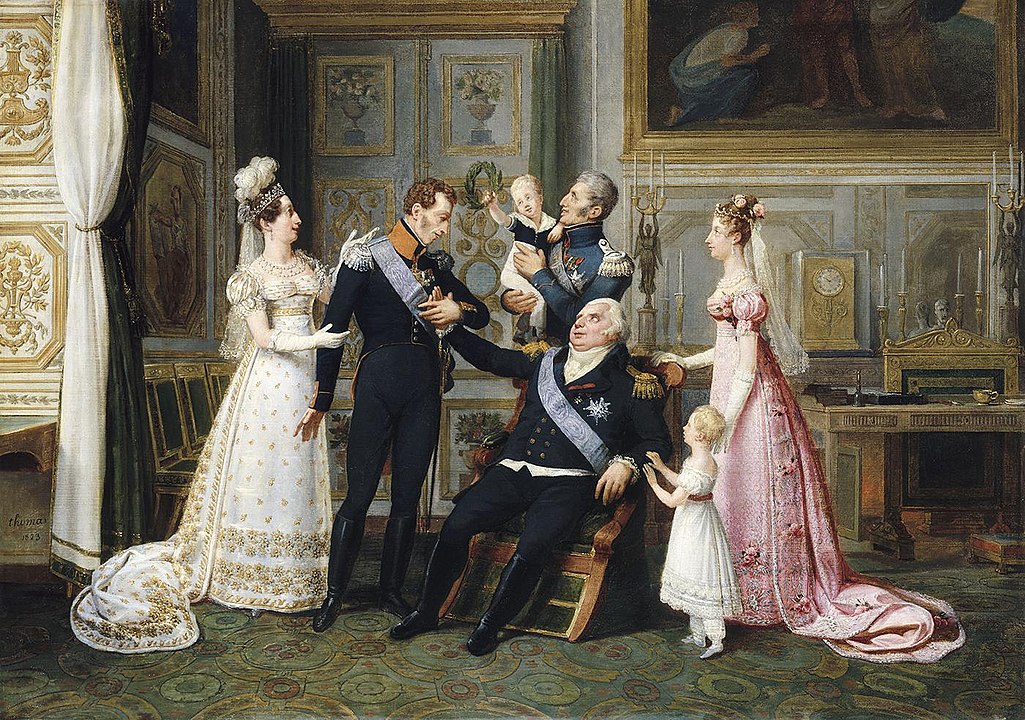
In his apartments at the Tuileries, Louis XVIII receives the Duke of Angoulême and his wife Marie-Thérèse, the one on the left. Standing behind the King is his brother, Count d'Artois. He holds in his arms the little Henry, Duke of Bordeaux and Count of Chambord. The lady to the right is Marie-Caroline de Bourbon-Sicile, duchesse de Berry, mother of Henry. The painting highlights the continuity of the Bourbon dynasty.
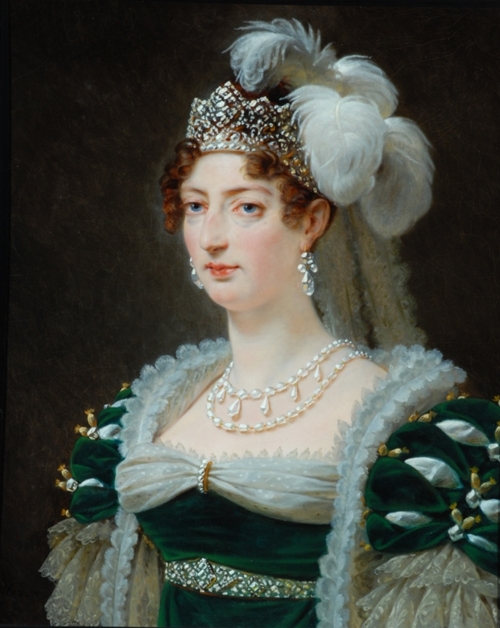 Marie Thérèse of France in 1817
Marie Thérèse of France in 1817Technically Marie-Thérèse was Queen of France for twenty minutes, on 2 August 1830. Her father-in-law signed the instrument of abdication, making Louis-Antoine King of France and Marie-Thérèse Queen. Her husband, although reluctantly, signed the same abdication document. This was the end of the reign of the house of Bourbon. It had delivered the Kings of France since 1589.
Marie-Thérèse and her relatives had to go into exile again. They would never return to France. They lived in England until 1833 and in Prague Castle as a guest of Emperor Francis I of Austria (Marie-Thérèse 's cousin).
In October 1836, the former Charles X and his court moved to Coronini Palace. This palace is situated in the outskirts of Gorizia, you can visit the palace or take a virtual tour.
Marie-Thérèse nursed her uncle there, he died of cholera shortly after they arrived in Italy. She lived in Gorizia until her husband died in 1844. Then she bought Schloss Frohsdorf in Austria. She moved there with Henri, Count of Chambord. He was the new claimant to the French throne since Louis-Antoine died.
Marie-Thérèse and her husband had taken Henry under their wings since he was age 12. Marie Thérèse was supposed to prepare him for ascension to the French throne. Many courtiers who supported his claim followed them to Frohsdorf and it became the French government in exile.
Marie-Thérèse was very close to Archduchess Sophie. She visited Schloss Frohsdorf frequently together with her son Franz-Joseph (who would mary Sisi).
Schloss Frohsdorf, nowadays called- Château Petit Versailles can be rented for weddings, special celebrations corporate festivities.
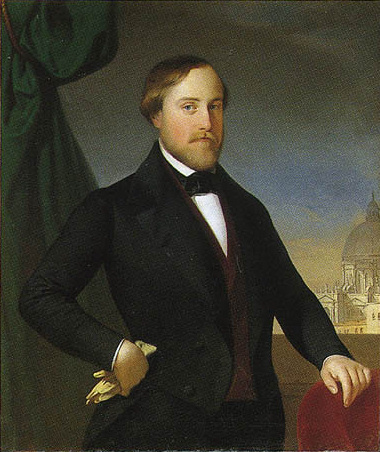 Henri, Count of Chambord
Henri, Count of ChambordThe life of Marie-Thérèse after the horrific revolution was completely devoted to the perseverance of the French monarchy, especially the House of Bourbon. Her marriage to her nephew, the adoption of her other nephew, the Comte de Chambord, the devotion to her uncles, all were attempts to assure the restoration of the throne. She worshipped her death parents as if they were saints. She owned a bloodied chemise, worn by her father on the scaffold, that she kept with all her life.
Marie-Thérèse died of pneumonia on 19 October 1851. Her body was taken by train to her final resting place. She lies in the crypt of the Franciscan monastery church of Castagnavizza, in Slovenia ( then it was still Austria). She was buried next to her husband, Louis XIX and her uncle, Charles X.
The inscription on Marie-Thérèse's tomb says, 'Queen Dowager of France'.
